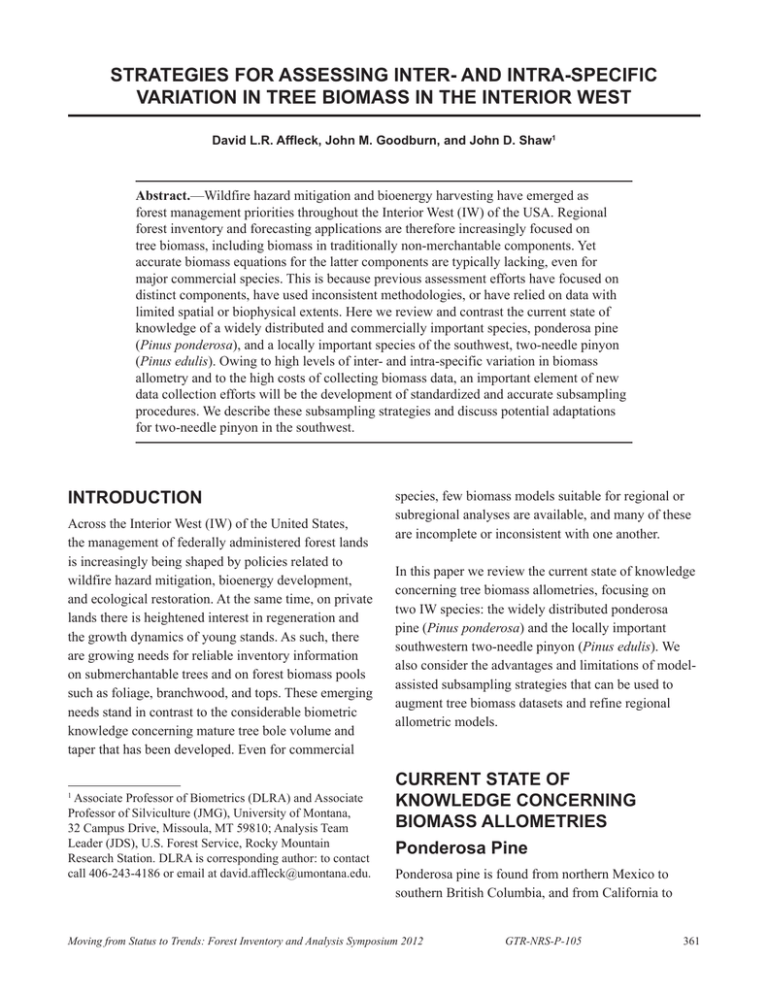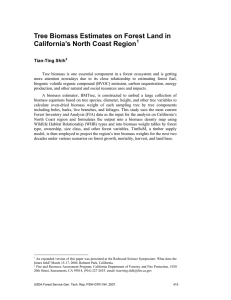STRATEGIES FOR ASSESSING INTER- AND INTRA-SPECIFIC
advertisement

STRATEGIES FOR ASSESSING INTER- AND INTRA-SPECIFIC VARIATION IN TREE BIOMASS IN THE INTERIOR WEST David L.R. Affleck, John M. Goodburn, and John D. Shaw1 Abstract.—Wildfire hazard mitigation and bioenergy harvesting have emerged as forest management priorities throughout the Interior West (IW) of the USA. Regional forest inventory and forecasting applications are therefore increasingly focused on tree biomass, including biomass in traditionally non-merchantable components. Yet accurate biomass equations for the latter components are typically lacking, even for major commercial species. This is because previous assessment efforts have focused on distinct components, have used inconsistent methodologies, or have relied on data with limited spatial or biophysical extents. Here we review and contrast the current state of knowledge of a widely distributed and commercially important species, ponderosa pine (Pinus ponderosa), and a locally important species of the southwest, two-needle pinyon (Pinus edulis). Owing to high levels of inter- and intra-specific variation in biomass allometry and to the high costs of collecting biomass data, an important element of new data collection efforts will be the development of standardized and accurate subsampling procedures. We describe these subsampling strategies and discuss potential adaptations for two-needle pinyon in the southwest. INTRODUCTION Across the Interior West (IW) of the United States, the management of federally administered forest lands is increasingly being shaped by policies related to wildfire hazard mitigation, bioenergy development, and ecological restoration. At the same time, on private lands there is heightened interest in regeneration and the growth dynamics of young stands. As such, there are growing needs for reliable inventory information on submerchantable trees and on forest biomass pools such as foliage, branchwood, and tops. These emerging needs stand in contrast to the considerable biometric knowledge concerning mature tree bole volume and taper that has been developed. Even for commercial 1 Associate Professor of Biometrics (DLRA) and Associate Professor of Silviculture (JMG), University of Montana, 32 Campus Drive, Missoula, MT 59810; Analysis Team Leader (JDS), U.S. Forest Service, Rocky Mountain Research Station. DLRA is corresponding author: to contact call 406-243-4186 or email at david.affleck@umontana.edu. species, few biomass models suitable for regional or subregional analyses are available, and many of these are incomplete or inconsistent with one another. In this paper we review the current state of knowledge concerning tree biomass allometries, focusing on two IW species: the widely distributed ponderosa pine (Pinus ponderosa) and the locally important southwestern two-needle pinyon (Pinus edulis). We also consider the advantages and limitations of modelassisted subsampling strategies that can be used to augment tree biomass datasets and refine regional allometric models. CURRENT STATE OF KNOWLEDGE CONCERNING BIOMASS ALLOMETRIES Ponderosa Pine Ponderosa pine is found from northern Mexico to southern British Columbia, and from California to Moving from Status to Trends: Forest Inventory and Analysis Symposium 2012 GTR-NRS-P-105 361 Nebraska. It is a commercially important species over much of the northern reaches of its range. It generally occupies relatively dry sites but is found over a broad climatic envelope: from the northern Sierras to the adjacent Great Basin it grows on sites with annual precipitation ranging from approximately 1800 mm/yr to 200 mm/yr (Callaway et al. 1994). Most of our understanding of the biomass allometries of ponderosa pine comes from studies conducted in the northern portion of the species’ range. Yet even the relatively intensive field work by, for example, Brown (1978) and Standish et al. (1985), had limited geographic support relative to the species’ overall distribution. Moreover, past studies often employed different (and varying) tree biomass measurement protocols and partitioned totals into distinct biomass components. Though not irresolvable, the latter issues do make it challenging to use previously collected data or previously developed models to inform regional or subregional analyses. From smaller-scale studies such as Callaway et al. (1994) and Bouffier et al. (2003), it is evident that this species’ biomass allocation patterns and wood density vary within the region owing to environmental and genetic differences; differences in data collection protocols complicate the detection and description of such variations. Two-Needle Pinyon In the southwestern United States, two-needle pinyon is a locally important species in terms of forest cover and secondary forest products. It is a woodland species ranging mostly over the states of Utah, Colorado, New Mexico, and Arizona. Two-needle pinyon is found on warmer and drier sites than ponderosa pine. It grows in both single-stem, excurrent forms (on better sites) and with spreading crowns and multiple stems (typical form at lower elevations). Compared to ponderosa pine, little has been published on the biomass allometries of two-needle pinyon or on its genetic variation or wood density characteristics. Few biomass studies have been conducted and these have been highly localized in terms of geographic extent and have been based on small sample sizes (i.e., 10 to 15 trees) (Darling 1967, Grier et al. 1992). BIOMASS SUBSAMPLING Motivations and Challenges Field assessment of tree biomass is an expensive undertaking in the mountainous and remote regions of the western United States. Besides access costs there are often difficulties associated with the destructive nature of the sampling (e.g., if large d.b.h. trees must be felled or if standard log lengths cannot be maintained). Materials processing costs are also significant with defoliation of branches being particularly time consuming (e.g., defoliation of firstorder branches can take more than one person-day for some coniferous species). At the same time, there is a multitude of site and stand factors that can influence the accumulation and apportionment of biomass, investigation of which necessitates the accumulation of relatively large samples of trees for any given species. To collect a large sample in the face of high per-tree costs requires consideration of subsampling strategies and potential sources of auxiliary (non-biomass) information. The disadvantage of subsampling for tree biomass is that within-tree sampling errors become confounded with among-tree variation. Put differently, residual among-tree variation is inflated by subsampling error, making it more difficult to identify and detect systematic variation in biomass attributable to tree, stand, or site factors. Thus, effective subsampling strategies must allow the size of the sample (i.e., the number of independently selected trees) to increase faster than tree-level uncertainty adds to the overall variance. Specifically, if the subsampling strategy is unbiased then the sample size under subsampling should be greater than the sample size under full measurement by a factor of at least 1 + (σe/σt)2, where σe is the standard deviation associated with the subsampling procedure and σt is the conditional standard deviation in biomass across trees with similar characteristics. Moving from Status to Trends: Forest Inventory and Analysis Symposium 2012 GTR-NRS-P-105 362 Development and Application Fundamental principles of tree allometry and past empirical work can be brought to bear to devise efficient and practical tree biomass subsampling strategies. As one example, for a given d.b.h. and height much of the tree-to-tree variation in bole biomass can be attributed to differences in bole taper. This suggests using previous taper modeling efforts to minimize costs associated with biomass measurements specific to the bole. Multiple taper studies have been conducted for ponderosa pine in the northwest; particularly noteworthy are multi-point equations such as those developed by Flewelling and Ernst (1996). Though parameterized for specific subregions of the northwest, the latter equations allow for fine calibration of predicted profiles to actual tree taper via the input of multiple upper stem height-diameter pairs (that are easily measured on the downed tree). Pointlevel predictions (inside- and outside-bark) from the taper profile, together with integrated volumes, can then be used as control variates, allowing for accurate estimation of bole biomass components from a random or systematic sample of discs. As a second example, numerous field studies (e.g., Monserud and Marshall1999) have shown strong relationships between branch basal area and branch mass for many coniferous species. Less strong are relationships between, on the one hand, branch basal area and, on the other, branch foliar mass or branch woody biomass. Nonetheless, such relationships form an important basis for biomass subsampling strategies because branch basal areas are more easily measured than branch masses (green or dry; whole or by component). Subsampling procedures can draw on these relationships via unequal probability designs (e.g., list sampling or randomized branch sampling, RBS) and at the estimation stage through the use of generalized ratio or regression estimators. Such strategies obviate the need to measure full crown weights in the field, a task that is both time-consuming and fraught with difficulties due to the prevalence of broken and buried branches. As part of an ongoing ponderosa pine biomass study in the northwest (Affleck and Turnquist 2012), RBS of first-order branches has been used to capitalize on the strong quadratic relationship between branch diameter and branch mass while carrying out the crown sampling in a single pass up the stem. The use of generalized regression estimators with RBS is also being studied as initial results have indicated that a number of conifer species do not exhibit area-preserving branching at the first-order level, a characteristic implicitly assumed in RBS. In developing biomass sampling strategies for twoneedle pinyon, there is considerably less mensurational knowledge to draw on. While volume equations have been developed for this species, we are aware of no work on taper. Flexible taper equations for other species might be substituted and used for control variate sampling, though the procedure would need to be modified for multi-stemmed growth forms. Inasmuch as the multi-stemmed growth form is common, it is anticipated that crown subsampling strategies based on branch scaling relationships will be more useful for this species. In particular, RBS strategies could be applied in different ways to estimate crown characteristics on single stems or across multiple stems. ACKNOWLEDGMENTS Funding for this research was provided by a joint venture agreement between the U.S. Forest Service and the University of Montana (11-JV-11242305-120), by the Joint Fire Science Program through a grant to DLRA and JMG (10-1-02-13), and by the Inland Northwest Growth and Yield Cooperative. Moving from Status to Trends: Forest Inventory and Analysis Symposium 2012 GTR-NRS-P-105 363 LITERATURE CITED Affleck, D.L.R.; Turnquist, B.R. 2012. Assessing the accuracy of crown biomass equations for the major commercial species of the interior northwest: study plan and preliminary results. In: McWilliams, W.; Roesch, F.A., eds. Monitoring Across Borders: 2010 Joint Meeting of the Forest Inventory and Analysis (FIA) Symposium and the Southern Mensurationists. Gen. Tech. Rep. SRS-157. Asheville, NC: U.S. Department of Agriculture, Forest Service, Southern Research Station: 247-254. Bouffier, L.A.; Gartner, B.L.; Domec, J.-C. 2003. Wood density and hydraulic properties of ponderosa pine from the Willamette Valley vs. the Cascade Mountains. Wood and Fiber Science. 35: 217-233. Brown, J.K. 1978. Weight and density of crowns of Rocky Mountain conifers. Res. Pap. INT197. Ogden, UT: U.S. Department of Agriculture, Forest Service, Intermountain Forest and Range Experiment Station. 56 p. Callaway, R.M.; DeLucia, E.H.; Schlesinger, W.H. 1994. Biomass allocation of montane and desert ponderosa pine: an analogy for response to climate change. Ecology. 75: 1474-1481. Darling, M.L.S. 1967. Structure and productivity of a pinyon-juniper woodland in Northern Arizona. Durham, NC: Duke University. Ph.D. dissertation. Flewelling, J.W.; Ernst, R.L. 1996. Stem profile estimation - east-side species. Unpublished report to the Inland Northwest Growth and Yield Cooperative. On file at the U.S. Department of Agriculture, Forest Service, Forest Management Service Center, Fort Collins, CO. Grier, H.L.; Elliott, K.C.; McCullough, D.G. 1992. Biomass distribution and productivity of Pinus edulis-Juniperus monosperma woodlands of north-central Arizona. Forest Ecology and Management. 50: 331-350. Monserud, R.A.; Marshall, J.D. 1999. Allometric crown relations in three northern Idaho conifer species. Canadian Journal of Forest Research. 29: 521-535. Standish, J.T.; Manning, G.H.; Demaerschalk, J.P. 1985. Development of biomass equations for British Columbia tree species. Information Report BC-X-264. Victoria, BC: Canadian Forestry Service, Pacific Forest Research Centre. The content of this paper reflects the views of the author(s), who are responsible for the facts and accuracy of the information presented herein. Moving from Status to Trends: Forest Inventory and Analysis Symposium 2012 GTR-NRS-P-105 364





